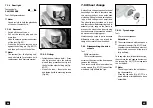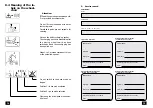
57
56
7.5.6.1 Exposing the batteries
1. Park the wheelchair on a level sur-
face and engage the parking brake.
Switch off the control unit and then
pull out the security plug.
2. Swivel up the seat. – See the Seat
section.
3. Pull out the main and battery fuses.
– See the 'Fuses' section.
4. Slacken the capstan-head screw (Fig.
74/
➀
).
5. Swivel the battery cover to the rear
and unhook it (Fig. 75).
The wheelchair is made ready for use
again in the reverse sequence.
74
75
▲
Switch off the control unit and then
pull out the main fuse before starting
work on the electrical system.
▲
Never touch the battery terminals
with tools, cable ends or other metal
objects when working on the
batteries.
!
Attention:
Batteries can explode if they come
into contact with sparks, e.g. due to
a short circuit of the battery termi-
nals!
!
Caution:
Battery acid is very caustic! Skin and
eyes can be injured, clothing and
flooring can be damaged.
☞
Note:
Rinse skin or body parts that have
come into contact with acid
immediately with running water for
several minutes. Then see a doctor.
Immediately remove clothing wetted
with acid. Wash clothes with soap
solution and rinse with much water.
▲
Always wash your hands after work-
ing on the batteries.
7.5.4 Battery replacement
The daily use of the electric wheelchair
places a high demand on the drive bat-
teries, they can only fulfil their function
when they are maintained and charged.
Batteries undergo a normal ageing proc-
ess. Both batteries must be replaced
when they no longer give the full pow-
er or are defective despite correct charg-
ing.
The use of batteries with different ca-
pacities is not permitted.
☞
Note:
Have a battery replacement carried
out by a specialist workshop because
they know about the possible risk sit-
uations and can correctly dispose of
defective batteries.
7.5.5 Safety information
▲
Keep children away from batteries,
accessory parts and packing
material.
▲
Avoid open flames and sparking in
the proximity of the batteries.
– Risk of explosion!










































